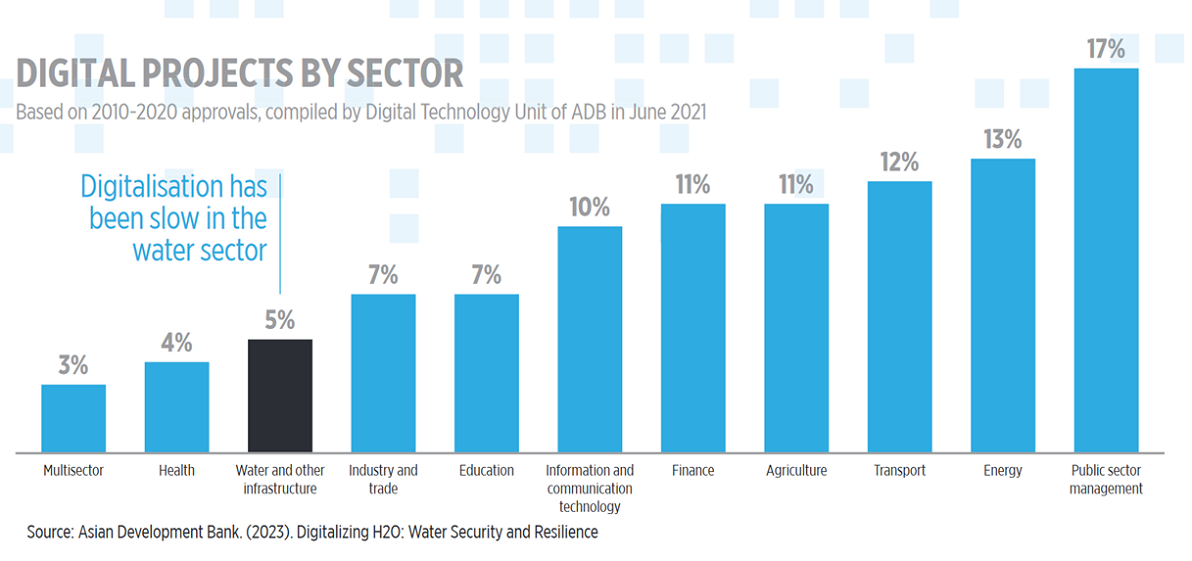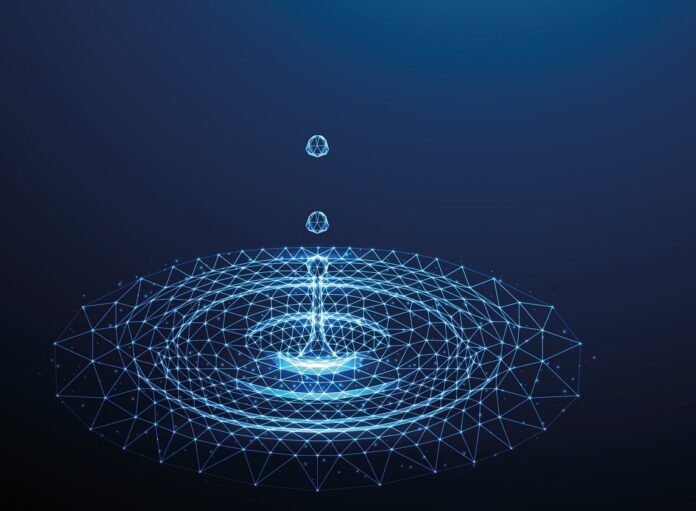Digitalisation is key for the water sector, but there is plenty to debate about the path ahead, as a recent workshop heard.
Digitalisation has the potential to enable water and sanitation service providers to do ‘More with Less’. When successful, digitalisation expands the service provider’s ability to plan better, organise and deliver services more efficiently, access and manage capital, and grow customers. However, digitalisation has remained slow, expensive, and inaccessible for many water and sanitation service providers (see graph, below).

At the IWA Water and Development Congress in Kigali, Rwanda, the IWA’s Digital Water Programme organised a workshop on 11 December to explore the experiences of public and private service providers, to better understand the factors influencing digitalisation and discuss levers and approaches to help scale affordable digital products and services for water and sanitation utilities.
The workshop had two panels. The first was moderated by Deepa Karthykeyan, from Athena Infonomics, and was designed to highlight the digitalisation experiences of utilities. The panel included: Grace Kabubu, from Nakuru Water and Sanitation Company in Kenya; Eng Mahmood Lutaaya, from National Water and Sewerage Company (NWSC) in Uganda; and Siemen Veenstra, lead water professional VEI and knowledge manager within the WaterWorX Water Operators Partnership (WOP) programme, in joint collaboration with UN Habitat Global Water Operators’ Partnerships Alliance (GWOPA).
The second panel was moderated by Dr Rachel Peletz, from the Aquaya Institute. It focused on bringing together perspectives of private sector service providers in serving utility and sector digital needs. Remi Kaupp, Executive Director of the Container-Based Sanitation Alliance (CBSA), and Dickson Marira, CEO of Wonderkid, a digital service company in Kenya, participated in the second panel.
The panellists and the participants engaged in a healthy debate on the themes of how software is built and used, and the role of regulation in shaping digitalisation journeys. The three key discussion themes that emerged from the workshop are summarised below.
Build vs. License
The session witnessed a lively discussion on approaches to digitalisation, with Lutaaya sharing NWSC’s positive experience of building its own software incrementally and internally. Lutaaya argued for freedom from vendor lock-ins and highlighted inflexibility, lack of transparency, and long-term costs that can be associated with the licensing approach. He shared how NWSC had worked step-by-step to build its own software solutions and expand its IT division to continue to improve and maintain software solutions.
Other members on the panel, including Kabubu, and utility representatives in the audience presented a counterpoint, arguing in favour of working with Software-as-a-Service (SAAS) platforms, as most smaller utilities do not have the capacity to hire and retain technology talent, and are more likely to benefit from automatic upgrades and security features that come built into licences.
Marira shared the evolution of his business from providing bespoke custom-built software solutions to developing a SAAS-based product called the Utility Master, and the benefits he said the SAAS-based approach offers. Marira argued that better licensing (i) may reduce high upfront costs, (ii) can avoid tender restrictions that limit innovation, and (iii) offers more flexibility to tailor design solutions and support full inclusion in working processes.
Veenstra highlighted the need for capacity development to effectively engage the utility to customise digital products and make them work within their operational context. Experiences from Lukanga WSC, a commercial utility in Zambia taking part in WaterWorX WOP with VEI, demonstrate that digitalisation is not to be ignored in an overall attempt to streamline the cost-effectiveness of operations, and improve upon management information systems.
All panellists emphasised the need for more rigorous reviews of the different utility software solutions made available to them, so utilities can make more informed purchasing decisions. Kabubu also added the need for reforms in public sector procurement, and development of better contracts and performance standards for digital service providers to improve the quality of outcomes in terms of adoption and use.
Karthykeyan summarised the discussion by calling for more evidence on the build vs. license approaches and analysis of the specific conditions and enablers influencing choices, benefits accrued, and the life-cycle costs.
“digitalisation has remained slow, expensive, and inaccessible for many water and sanitation service providers”
Normative vs. Prescriptive Regulation
The workshop participants engaged in an interesting discussion on the role of regulation in utility digitalisation journeys, noting that regulation can be a key driver of digitalisation. Utility representatives on the panel, as well as in the audience, argued that regulation induced utilities to prioritise investments in software solutions that may have limited implications for utility operational performance. They recommended that regulation should be more normative and less prescriptive, with some general guidelines on what ‘good’ looks like without interfering or influencing ‘how’ it is operationalised, to avoid ‘regulation burden’.
Representatives from regulatory agencies, however, responded by emphasising the role of regulators in protecting the integrity of the sector, and argued that there was a need to be prescriptive to standardise the nature and quality of data. The workshop participants called for further dialogue and investigation on the points of dissonance/overlap between regulators and utilities, and how this affects digitalisation journeys.
Incremental vs. Disruptive
Kaupp, from CBSA, presented container-based sanitation (CBS) as ‘Toilets as a Service’ and emphasised the critical role that digitalisation plays in building, sustaining, and improving customer experience and professionalising sanitation services. Here, he shared CBSA’s experience with building software that could be leveraged by CBS operators around the world, and highlighted some of the challenges in operationalising a ‘one size fits all’ approach to digitalisation – when apparent commonalities between service providers hide more varied needs in practice.
Kaupp also went on to highlight how it is easier to procure grant financing for custom-built software and have the borrowers/grantees maintain it – for better or for worse – which could influence digitalisation approaches and choices.
Marira went on to outline the limitations of a donor-induced custom-built approach, particularly in contexts with limited staffing norms and capacity to invest in maintaining the software and putting it to effective use.
There was a healthy debate on the opportunities for donor and other stakeholder coordination to help build elegant software as digital public goods that could lower the cost of adoption and implementation, ultimately accelerating digitalisation, particularly in contexts where there is stronger governance and capacity to engage, customise, and use digital solutions.
Building on the debate
To strengthen and inform a community of practice on utility digitalisation, a series of webinars, workshops, and briefs is planned by the IWA Digital Water Programme Steering Committee, in partnership with organisations such as the African Water and Sanitation Utility Association and UN Habitat GWOPA. •
More information








